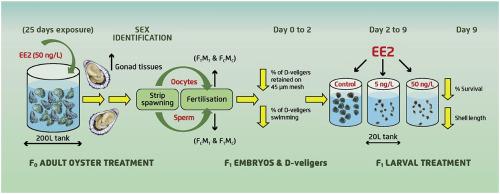Environmental Pollution ( IF 7.6 ) Pub Date : 2020-07-03 , DOI: 10.1016/j.envpol.2020.114994 Rafiquel Islam 1 , Richard Man Kit Yu 2 , Wayne A O'Connor 3 , Thi Kim Anh Tran 4 , Megan Andrew-Priestley 5 , Frederic D L Leusch 6 , Geoff R MacFarlane 2

|
Very little is currently known regarding the effects of estrogenic endocrine disrupting chemicals on embryonic and larval development in molluscs, nor the potential for effects of parental (F0) exposure on resultant F1 offspring. In this study, we assessed the embryotoxic impacts of exposure to environmentally relevant concentrations of the synthetic estrogen, 17α-ethinylestradiol (EE2), to male and female parents (50 ng/L) and their offspring (5 and 50 ng/L) in the native Australian Sydney rock oyster, Saccostrea glomerata. There were no detectable effects of parental exposure on fertilisation success, proportions of early larval (F1) morphs and unfertilized eggs. Offspring impacts were evidenced in terms of developmental delays, with decreased percentages of D-veligers retained by 45 μm mesh, along with a reduction of swimming capabilities of larvae at 2 days post-fertilisation (dpf) when both parents had been exposed to 50 ng/L EE2. Although no significant parental effects were found on the survival of F1 larvae at 9 dpf, retardation of shell growth was observed on F1 larvae in treatments where both parents had been exposed to 50 ng/L EE2. Subsequent larval exposure from 2 to 9 dpf caused declines in survival and reduction of shell length in F1 larvae at both 5 and 50 ng/L EE2 across all parental exposure treatments. Collectively, parental EE2 imparts effects on offspring in terms of retardation of larval development, and subsequent offspring exposure to EE2 further exacerbates impacts to development. Future research should aim to understand the potential mechanisms of EE2 induced toxicity and its transmission resulting in altered phenotypes of the F1 generation.
中文翻译:

父母对合成雌激素17α-炔雌醇(EE2)的暴露会影响悉尼牡蛎(Saccostrea glomerata)牡蛎的后代发育。
很少是目前已知的关于雌激素内分泌干扰物对胚胎和幼虫发育中软体动物的影响,也不是为父母效应(F电位0)曝光于所得˚F 1后代。在这项研究中,我们评估了暴露于环境相关浓度的合成雌激素17α-炔雌醇(EE2)对雄性和雌性父母(50 ng / L)及其后代(5和50 ng / L)的胚胎毒性影响。澳大利亚本地的悉尼牡蛎,Saccostrea glomerata。父母暴露对受精成功率,幼虫比例(F 1)变形和未受精的卵。在发育延迟方面证明了对后代的影响,D-veligers被45μm网孔保留的百分比降低,并且在父母双方都暴露于50 ng的受精后(dpf)的幼虫游泳能力下降。 / L EE2。尽管在9 dpf时对F 1幼虫的存活没有明显的父母影响,但是在父母双方都暴露于50 ng / L EE2的处理中,F 1幼虫的壳生长受到了抑制。随后的幼虫暴露量从2到9 dpf导致F 1的存活率下降和壳长减少在所有父母接触治疗中,幼虫的EE2浓度均为5和50 ng / L。总体而言,亲本EE2会在幼虫发育迟缓方面对后代产生影响,随后的后代暴露于EE2会进一步加剧对发育的影响。未来的研究应该旨在了解EE2诱导毒性及其传播导致F 1代表型改变的潜在机制。











































 京公网安备 11010802027423号
京公网安备 11010802027423号